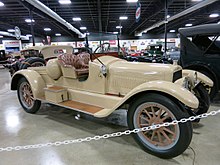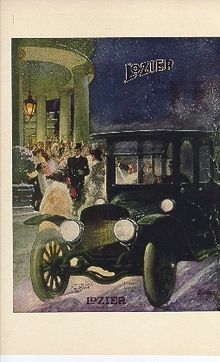Lozier Motor Company
The Lozier Motor Company was an American bicycle and automobile manufacturer. The company produced luxury cars and was based in Plattsburgh (New York) from 1900 to 1910 and Detroit (Michigan) from 1910 to 1918 .
Sewing machines and bicycles
The company was founded by Henry Abraham Lozier from Indiana as Henry A. Lozier and Company in Cleveland ( Ohio founded). It made sewing machines and bicycles . The latter were sold under the Cleveland brand name and were very successful. At the height of the bicycle boom, Lozier started looking for other products. Plant manager George R. Burwell and technician John G. Perrin suggested internal combustion engines. A development team was formed under Burwell's leadership, including bicycle mechanic Frederick C. Chandler . 1898 she experimented with a steam carriage after Serpollet principle and constructed a to the Rochet - motortricycle ajar vehicle De Dion-Bouton - cylinder engine . Maybe was Harry A. Lozier , the son of the company founder, part of this development. One of the first engines powered a motorboat, which was used to conduct a successful test drive from Cleveland across the Erie Canal and the Hudson River to Plattsburgh on Lake Champlain , where new production facilities were planned. At that time the company name was changed to Lozier Manufacturing Company .
ABC and the Cleveland Three-Wheeler
A production of 100 three-wheelers was prepared.
In 1897 or 1898, Henry Lozier sold the bicycle production, which was distributed over four factories (including in Toledo (Ohio) ) for four million US $ - and thus with great profit - to the American Bicycle Company (ABC) of Albert Augustus Pope in Hartford (Connecticut) , the largest bicycle manufacturer in the USA. Part of the deal was the rights and existing components to the motor tricycle, which was presented in January 1900 at the annual bicycle exhibition in New York's Madison Square Garden .
It was manufactured from 1900 to 1901 by ABC as the Cleveland Three-Wheeler at the Cleveland location prepared by Lozier. About 100 copies were built.
Lozier Motor Company
Henry Lozier largely withdrew from the business that Harry Lozier was now running. He still needed his father's approval to build an automobile factory in Plattsburgh. At first they made boat engines and repaired automobiles of other brands. Lozier Manufacturing's unsold parts were organized in 1900 as the Lozier Motor Company based in Plattsburgh.
Industrial espionage
In 1901 two more prototypes were made, one with a steam engine and one with a gasoline engine. Burwell was not convinced of the result. In 1902 he sent the engineer JM Whitbeck to Europe to find out about the state of the art there. The following January, John Perrin left the company. Unofficially, however, he remained connected to him; Burwell paid his wages and expenses. To do this, Perrin looked around the importers of foreign models on the east coast and reported on technical details. When wealthy photographer and businessman James L. Breese broke down his Mercedes , Burwell offered him a free repair. Of course, on this occasion, he examined the advanced technical solutions of the German vehicle.
Henry Lozier died in May 1903 and Harry took over the company entirely. Whitbeck brought detailed drawings of vehicles from leading manufacturers, including Mercedes, Mors , Charron , Darracq and CGV
Lozier automobiles
In 1905, at the New York Auto Show in Madison Square Garden, the first proprietary car was presented, largely developed by John Perrin. Lozier were luxury automobiles and, alongside brands such as Alco , Pierce-Arrow , Locomobile , Cunningham , Chadwick , Simplex and Thomas, were for a time among the most expensive cars available in the USA. In 1910 the models were offered at prices between US $ 4600 and US $ 7750. In the same year there was a Cadillac for US $ 1,600 and a Packard for US $ 3,200. The average annual wage for Americans at that time was around US $ 750, a Ford Model T Touring cost US $ 950 in 1910; a price that should be halved by the end of 1916.
As early as 1909, a group of investors led by the Detroit Athletic Club and Harry M. Jewett , who already controlled the Paige-Detroit Motor Car Company , made a financing offer to Harry Lozier. Analogous to Packard's successful business model, the new investors wanted to invest in Lozier and increase production. After initial hesitation and with the assurance of a majority of 51%, Lozier agreed in February 1910. The new co-owners organized capital of US $ 2 million, half of which they contributed and half of which was organized on the New York Stock Exchange . Architect Albert Kahn was hired to build a new factory on Mack Avenue in Detroit. It was moved into in 1911. Kahn had previously built the Packard factory in Detroit as the first reinforced concrete production facility .
It was around this time that Burwell retired; He was succeeded as chief engineer by George Perrin. Frederick Chandler also rose in the company. After a time in Hamburg as the brand's representative in Germany, he became sales manager at Lozier. It soon became apparent, however, that the views of the investors and the management team were becoming less and less compatible. With the appearance of new automobile manufacturers, Lozier also came under increasing pressure. In July 1912 Harry Lozier had to leave. Frederick Chandler left the company in 1913 with four senior executives including Whitbeck and started his own company, the Chandler Motor Car Company , which made cars similar to Lozier but at a significantly lower price. Chandler took away many of Lozier's executives, a bloodletting Lozier never recovered from. Perrin would have liked to leave, but was contractually bound to Lozier until 1915. Jewett appointed Joseph M. Gilbert as the new managing director.
In 1913, however, Lozier presented the Big Six model in Los Angeles , whose engine developed 88 bhp (65 kW) and which was equipped with electric lighting as standard. The touring cars and roadsters cost US $ 5,000, the sedans and landaulets US $ 6,500. It was followed by the Light Six Metropolitan (52 bhp (38 kW)) with an electric starter and electric lighting. The runabout cost US $ 3250, the coupe US $ 3850 and the sedan US $ 4450.
Lozier wanted to save himself with vehicles of the middle class and in 1914 offered a four-cylinder car designed by Perrin for US $ 2000. This Model 84 was not a sales success and the company's financial situation continued to deteriorate. Even moving to smaller facilities didn't help. After an unsuccessful attempt to merge with Ford , the company had to file for bankruptcy in 1915 .
Because of its small market segment, only a few thousand Loziers were made during the company's short existence. 1912 was the best year with 600 vehicles.
Various bankruptcy trustees kept production (5 cars per day) up until 1918, when the company finally closed its doors.
Motorsport
In 1911, a Lozier was entered in the first Indianapolis 500 race. The car with Ralph Mulford as driver took second place behind Ray Harroun with his Marmon Wasp after a controversial decision by the race management , but many spectators said that Mulfords Lozier actually won the race. On March 19 of the same year, an advertising pamphlet from Lozier announced that a standard model 51 with 51 bhp (37.5 kW), driven by Teddy Tetzlaff , had set a world record of 100 miles (161 km) in 1:14:29 h . Mulford became AAA Champion of 1911.
Lozier models
| model | Construction period | cylinder | power | wheelbase |
|---|---|---|---|---|
| B. | 1905 | 4 row | 35 bhp (25.7 kW) | 2934 mm |
| C. | 1906 | 4 row | 35 bhp (25.7 kW) | 2972 mm |
| D. | 1906 | 4 row | 40 bhp (29 kW) | 2972 mm |
| E. | 1906-1907 | 4 row | 60 bhp (44 kW) | 3048 mm |
| F. | 1907 | 4 row | 40 bhp (29 kW) | 2972 mm |
| G | 1908-1909 | 4 row | 33 bhp (24 kW) | 2946-2972 mm |
| H | 1908-1910 | 4 row | 45 bhp (33 kW) | 3150 mm |
| I. | 1908-1910 | 6 row | 50–51 bhp (37–37.5 kW) | 3150-3327 mm |
| J | 1910 | 6 row | 33 bhp (24 kW) | 2946 mm |
| 46 | 1911-1912 | 4 row | 46 bhp (34 kW) | 3150 mm |
| 51 | 1911-1912 | 6 row | 51 bhp (37.5 kW) | 3327 mm |
| 77 "Light Six" | 1913-1914 | 6 row | 52 bhp (38 kW) | 3239 mm |
| 72 "Big Six" | 1913 | 6 row | 88 bhp (65 kW) | 3327 mm |
| 84 | 1914 / 1917-1918 | 4 row | 49 bhp (36 kW) | 3048 mm |
| 82 | 1915-1918 | 6 row | 61 bhp (45 kW) | 3353 mm |
literature
- Beverly Rae Kimes (ed.), Henry Austin Clark Jr.: Standard Catalog of American Cars 1805-1942. 3. Edition. Krause Publications, Iola WI, 1996; ISBN 0-87341-428-4 .
- Beverly Rae Kimes: Pioneers, Engineers, and Scoundrels: The Dawn of the Automobile in America. Ed. SAE ( Society of Automotive Engineers ) Permissions, Warrendale PA, 2005; ISBN 0-7680-1431-X .
- Griffith Borgeson: The Golden Age of the American Racing Car. Ed. SAE ( Society of Automotive Engineers ), Warrendale PA, 2nd edition, 1998; ISBN 0-7680-0023-8 .
- Robert Dick: Auto Racing Comes of Age: A Transatlantic View of the Cars, Drivers and Speedways, 1900-1925. Mcfarland & Co. Inc., 2013; ISBN 0-78646-670-7 .
- GN Georgano (Ed.): Complete Encyclopedia of Motorcars, 1885 to the Present ; Dutton Press, New York, 2nd edition (hardcover) 1973, ISBN 0-525-08351-0 .
- Robert D. Dluhy: American Automobiles of the Brass Era: Essential Specifications of 4,000+ Gasoline Powered Passenger Cars, 1906-1915, with a Statistical and Historical Overview. Mcfarland & Co Inc. publishers, Jefferson NC, 2013; ISBN 0-78647-136-0 .
Web links
- Lozier at Conceptcarz.com
- Racing pictures by James Walter Collinge 3rd, 4th and 9th picture of Teddy Tetzlaff with a Lozier.
- Hemmings, September 2007: Frederick C. Chandler. (Accessed March 3, 2017)
Individual evidence
- ↑ a b c Floyd Clymer: Treasury of Early American Automobiles, 1877-1925. McGraw-Hill, New York 1950, p. 329
- ↑ a b c d e f g h i j Beverly Ray Kimes / Henry Austin Clark: Standard Catalog of American Cars 1805–1942. , Iola WI 1996, pp. 903-904.
- ↑ a b Hemmings: Frederick C. Chandler.
- ↑ Beverly Ray Kimes / Henry Austin Clark: Standard Catalog of American Cars 1805-1942. , Iola WI 1996, p. 343.
- ↑ Beverly Ray Kimes / Henry Austin Clark: Standard Catalog of American Cars 1805-1942. , Iola WI 1985
- ↑ Beverly Ray Kimes / Henry Austin Clark: Standard Catalog of American Cars 1805-1942 , Iola WI 1996, p. 576.
- ↑ Beverly Ray Kimes / Henry Austin Clark: Standard Catalog of American Cars 1805-1942 , Iola WI 1996, p. 580.
- ↑ Beverly Ray Kimes: Pioneers, Engineers, and Scoundrels: The Dawn of the Automobile in America , Warrendale PA 2005, p. 358.


